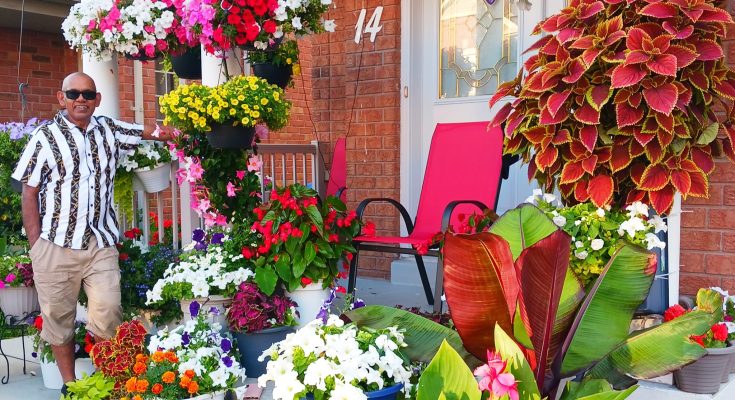If you’re looking for a vibrant pop of color to add to your small garden, Summer Crush bigleaf hydrangea (Hydrangea macrophylla ‘Bailmacfive’) is a winner. Mopheads bloom in either neon purple or raspberry red—perfect for brightening up the yard in a flash. Best planted in fall or early spring, its compact size (a rounded 18-to-36 inches) makes it ideal for smaller spaces or containers. It can just as easily be worked into larger landscapes.
If you thought the draw of this dazzling, berry-hued wonder was its attention-seeking color, think again. What makes Endless Summer hydrangeas of any variety so popular is their repeat blooming. These little beauties will make a show in the late spring and then go for round two later in the summer, blooming off the current season’s growth. Other bigleaf varieties only bloom once a year and on the previous year’s growth, meaning if you botched last year’s pruning, you’ll have to wait another year before seeing those beautiful floral globes again. All parts of the hydrangea plant are toxic to cats, dogs, horses, and people, so keep pets and small children away.12
Plant Attributes
Summer Crush Hydrangea Care
Summer Crush hydrangeas are well suited to USDA Plant Hardiness Zones 4-9. They’re a hardy choice for just about the entire South, excluding the bottom half of Florida as well as the western coast of the state’s panhandle.
These beautiful, compact plants flower not just on old wood, in the classic way, but also on new spring shoots from the base. So even if your plants are killed to the ground, you can look forward to a lovely summer and early fall display. Like other bigleaf hydrangeas, they will perform best with consistent moisture and afternoon shade in the South.
Light
As with other mophead or French hydrangeas, Summer Crush requires morning sun and afternoon shade. If you’re in a warmer zone (8-9), limit the amount of morning sun to just a couple of hours. At the far north end of its range (Zone 4 or 5a), this hydrangea can handle as much as six hours of sun.
Pay attention to sun patterns on your intended planting location for a few days before selecting the best spot in your garden for a Summer Crush. If you can’t quite commit, or don’t have a spot with ideal sun exposure, consider potting your hydrangea instead.
Soil
Plant in moist but well-drained fertile soil and use organic mulches in spring to feed the plant and conserve moisture. Summer Crush prefers loamy soil, but you can amend clay with organic matter to improve drainage or add peat and compost to sandy soils to retain moisture. Try growing hydrangeas in containers if you have very heavy or poor soil, using high-quality potting mix that contains organic matter.
Summer Crush’s color will vary according to the acidity of your soil. Soils with a pH close to neutral or alkaline (above 6.0) results in pink blooms (or raspberry red, in the case of Summer Crush). For purple or blue blooms, you need acidic soil. To make your soil more alkaline, use garden lime according to package directions. To make it more acidic, use aluminum sulfate.
Water
Newly planted hydrangeas must be watered regularly until established, but even established hydrangeas need watering during dry weather. If the soil feels dry, give the hydrangeas a good soak. They prefer a heavy watering once a week or so, compared to a light sprinkling daily. More frequent watering may be necessary during dry or hot weather.
Soil should ideally stay moist, but not wet. Water at the base of the plant in the morning so the hydrangea has a chance to soak up the moisture before the heat of the day. A layer of mulch will help conserve moisture.
Temperature And Humidity
Hydrangeas will burn up in a hot climate unless they have some protection from the afternoon sun. The farther South you live, the more shade you should provide.
The blooms are carried at the ends of the branches, both on new shoots that develop from the base of the plant in spring, and on side shoots that come from older stems that have overwintered. Late freezes can kill off the first bloom if stems aren’t adequately protected. In warmer climates, you will see two waves of blooming, one in early summer and one in late summer.
Fertilizer
Using a fertilizer blended for hydrangeas will give the best results, and is especially important if you are growing your plants in containers. Choose a slow-release, bloom-boosting, granular fertilizer that is high in phosphorus. Apply in early spring according to label directions once you see new green growth starting to appear. Apply a second time in June or July to promote a second wave of blooms. Over-fertilizing can reduce blooming.
:max_bytes(150000):strip_icc():format(webp)/Hydrangea-macrophylla-dark-blue-big-592f13a45f9b585950e11a93.jpg)
Other Types Of Hydrangeas
While the Summer Crush is considered one of the “mophead” hydrangeas, there are some other types of big leaf hydrangea. Lacecap and mountain hydrangeas can take the cold a bit better. Some mophead hydrangeas will do fine in colder areas as long as the winter is not too cold and dry. The condition hydrangeas are most sensitive to is being exposed to a freeze after an extended warm spell. In those areas, additional protection may be required.
The scientific name for lacecap hydrangeas is Hydrangea macrophylla normalis. Lacecaps are identical to mopheads in every way except the shape of their blooms. The little buds in the center of the lacecap are the fertile flowers, and the large showy blossoms around the outer edge are the sterile flowers.
Pruning
Summer Crush hydrangea need very little pruning. Remove stems that you’re certain didn’t survive the winter once green growth has appeared. Deadheading after the first flush of blooms in spring or early summer can encourage a second round of flowers later in summer. Then leave those late summer blooms in place until the following spring. Otherwise, you may accidentally remove next spring’s flower buds.
Propagating Summer Crush Hydrangea
Summer Crush hydrangea is patent-protected and cannot be propagated.
Potting And Repotting Summer Crush Hydrangea
Summer Crush’s compact size makes it ideal for planting in containers. The pot you choose should be a few inches wider than the nursery container and include drainage holes. If you want to keep the pot for several seasons, a container at least 15-18 inches wide is best. Fill the container partway with fresh potting mix that includes a slow-release fertilizer (alternatively, you can fertilize with granules after planting). Place the hydrangea in the container so it is about an inch below the top. Fill in around the plant with potting mix until it is level with the hydrangea’s soil line. Then water well.
Summer Crush should last a few seasons in a larger pot, but once roots begin to emerge through the drainage holes and it becomes harder to keep the plant watered, repot it with fresh potting mix in a larger container.
Overwintering
Adding a few inches of mulch, leaves, or straw should provide ample protection for hydrangeas where frosts occur in the South. To protect from hard frosts, pile leaves or straw up to 12 inches high. Leave the dried blooms on the stems until early spring, as pruning in fall or winter could mean you see fewer flowers the following year. Wait until all danger of frost has passed before removing excess mulch so you don’t lose new buds.
For container plants, simply move them into a cool space such as a garage or basement for winter. Water lightly throughout winter since the plant will not receive rainfall.
How To Get Summer Crush Hydrangea To Bloom
Even if you are careful to prune at the correct time, this particular varietal gives a dismal performance when late spring frosts damage leaves and buds. Make sure to protect the stems if you have a cold snap. In the South, excessive heat and drought can also interfere with flowering. Make sure to water adequately and use bloom-boosting fertilizer with a higher phosphorus level that is designed for flowers. Too much fertilizer and even too much watering can interfere with blooming.
Common Pests & Plant Diseases
The Summer Crush Hydrangea rarely suffers from any pests or diseases, and this easy-care plant doesn’t need anything special to fill your garden with months of wonderful color. Aphids and other insects can be sprayed off with a strong stream of water or treated with insecticidal soap.
Summer Crush can be infected with anthracnose, which begins as round, brown leaf spots with a red or purple ring. Anthracnose can spread into larger brown patches. Remove affected leaves and dispose of them. Spray foliage with a fungicide and repeat as necessary.
Common Problems With Summer Crush Hydrangea
Summer Crush is an Endless Summer hydrangea bred for good disease resistance. Problems with this plant most frequently occur from incorrect watering or pruning.
Brown Leaves
If the tips of your hydrangea turn brown, this means the plant is not receiving adequate moisture. Fading leaves with brown leaf margins are another indication that you need to water more frequently, especially during dry, hot weather. Browning leaves can also be an indication your hydrangea was planted in too much sun, especially in Zone 8 or 9. A couple of hours of morning sun is best in a hotter climate.
Wilting Plant
If your plant is wilting in the heat, make sure to give it a really good soak in the mornings so it has time to absorb the water before the afternoon. Check the soil first to make sure it isn’t already moist. Sometimes hydrangeas will wilt in the heat even when adequately watered, then recover once the temperature cools. Also, add mulch under the plant if the soil is bare.
Spotty Or Brown Flowers
Too much sun can fry the flowers just like it can scorch the leaves. Also, be careful not to wet hydrangea flowers when watering, especially on a sunny day.
No Blooms
Endless Summer hydrangeas sometimes take a year or two to fully establish and bloom well. Late frosts can kill the flower buds on old wood in spring, while heat or drought can damage flower buds on new growth. Avoid high-nitrogen fertilizers that can interfere with flowering and keep a close eye on soil moisture. And of course, be careful not to remove buds when pruning.



